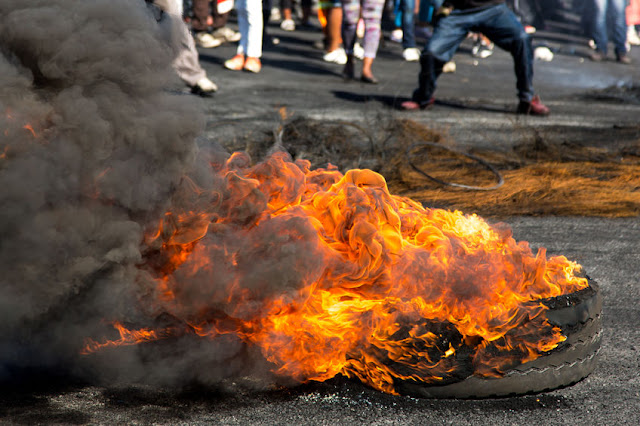As We Think - Greatest Thoughts : We speak through fire and vandalism
We speak
through fire and vandalism – is there power in this or is this is a sign
of powerlessness amongst us.
Photo credit: https://lh3.googleusercontent.com/
Protest’s power to set agendas is high, it seems, but its power to persuade is limited.Fire is a powerful force. When that power is managed, it has
many uses. It creates electricity and heat, it cooks food, and it
keeps farmland healthy. When it is unmanaged, it is destructive. This
includes arson, which is when someone purposefully starts a fire to
hurt people or destroy property.
A protest is an event or action where people gather with
others to publicly express their opinions about something that is happening in
society. There are a variety of potential goals for a protest: influence public
opinion, draw attention to and share information about a perceived injustice,
gain a wide audience for the cause, push public policy or legislation forward,
learn more about an issue, connect with others who feel passionate about the
issue, speak one's truth and bear witness. Protests can also provide inspiration
and a sense of being part of a larger movement. The overarching purpose of
protests is to demand change.
We burn, we vandalize and the message is clear service
delivery – electricity
The term ‘service delivery protest’ is thus loosely used to
the detriment of analytic clarity. Having originated as a discourse of the
public sector, it bears similarity to the apartheid-era catchphrase ‘township
unrest’ which served then as an umbrella term for a diverse range of political
actions such as rent and consumer boycotts, labour strikes and student revolts
(Friedman 1987, Mayekiso 1996). Similarly, ‘service delivery protest’ is
functioning as a catch-all term for multiple issues of governance and
government.
The messages of grievance emerging from protest action are
far-ranging: lack of communication with municipal authorities, poor quality of
services, allegations of nepotism and corruption, political in-fighting and
problems with community development projects related to contracts and tenders
(Booysens 2009:130). The drivers of protest actions often become enmeshed with
broader national concerns about macro-structural issues such as poverty, land
reform and unemployment. Cross-border protests and xenophobia have also
featured in the configuration of ‘service delivery’ protest action (Alexander
2010).
The question is – is there power in this or a sign of powerlessness?
Protests allow the people to believe they have a voice, and
that voice is being heard. They may have a voice, and that voice may be heard,
but it doesn’t necessarily result in anything other than a day in the sunshine
and some much-needed exercise. Their voices are nothing more than noise to the
leaders.
Sometimes it gives the people the illusion of having some
kind of power and allows them to vent their anger and shake their fists at
those with whom they are angry.
“It’s a Pressure-Release Valve for the people and
a Safety Valve for the leaders.”
It tells the leaders that a portion of those they lead is
unhappy about something - which is something they expect to always be the case
anyway.
There is a growing body of evidence that links the positive effect of access to service delivery to better socio-economic conditions and opportunities. Researchers describe capabilities as an individual’s and a community’s capacity to cope or recover from setbacks and to function in challenging times. People develop skills and knowledge through access to public services and education infrastructure that help them to transition out of poverty, and to social security that protects them against vulnerabilities. For example, the education that they receive at schools and libraries gives them access to job opportunities, and the counselling they receive at clinics might help them to seek medical assistance timeously. Violent and destructive protests such as the burning and destruction of public infrastructure can therefore diminish their future capabilities. Yet, people burn or destroy public infrastructure when they feel excluded or have inadequate access to services.
As We Think - Greatest Thoughs



Comments
Post a Comment